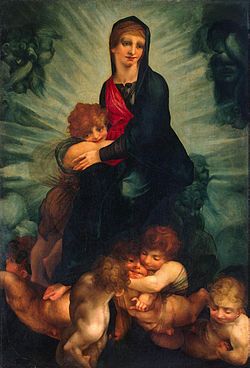
Michelangelo di Lodovico Buonarroti Simoni, known mononymously as Michelangelo, was an Italian sculptor, painter, architect, and poet of the High Renaissance. Born in the Republic of Florence, his work was inspired by models from classical antiquity and had a lasting influence on Western art. Michelangelo's creative abilities and mastery in a range of artistic arenas define him as an archetypal Renaissance man, along with his rival and elder contemporary, Leonardo da Vinci. Given the sheer volume of surviving correspondence, sketches, and reminiscences, Michelangelo is one of the best-documented artists of the 16th century. He was lauded by contemporary biographers as the most accomplished artist of his era.

Pietro Perugino, an Italian Renaissance painter of the Umbrian school, developed some of the qualities that found classic expression in the High Renaissance. Raphael became his most famous pupil.
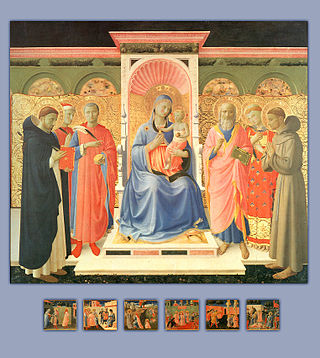
In art, a sacra conversazione, meaning "holy conversation", is a genre developed in Italian Renaissance painting, with a depiction of the Virgin and Child amidst a group of saints in a relatively informal grouping, as opposed to the more rigid and hierarchical compositions of earlier periods. Donor portraits may also be included, generally kneeling, often their patron saint is presenting them to the Virgin, and angels are frequently in attendance.
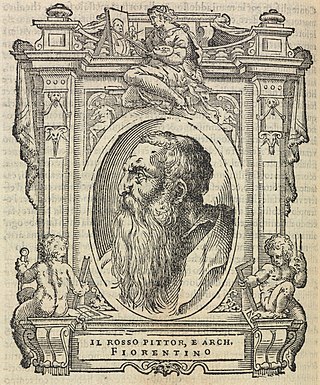
Giovanni Battista di Jacopo, known as Rosso Fiorentino, or Il Rosso, was an Italian Mannerist painter who worked in oil and fresco and belonged to the Florentine school.
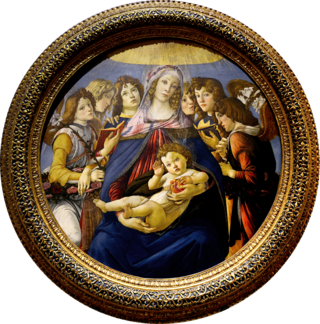
The Madonna of the Pomegranate was painted in circa 1487 with tempera on a wood panel by Sandro Botticelli. It is now in the Uffizi in Florence. Sandro Botticelli was a leading Italian Renaissance artist from Florence, Italy. The Madonna (art) uses the circular format, better known as a tondo, which focuses the attention on the main characters, the Virgin Mary and baby Jesus, who are surrounded symmetrically by angels on each side. Botticelli's use of tempera grassa give the characters a real look, better known as a "naturalistic" style, which is common during the Renaissance. The Virgin Mary is holding baby Jesus gently in her arms while holding a pomegranate in her left hand.
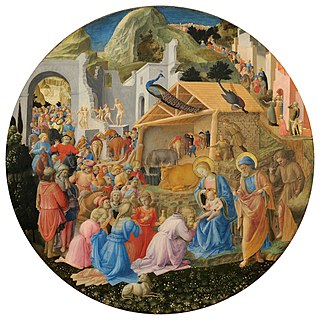
A tondo is a Renaissance term for a circular work of art, either a painting or a sculpture. The word derives from the Italian rotondo, "round". The term is usually not used in English for small round paintings, but only those over about 60 cm in diameter, thus excluding many round portrait miniatures – for sculpture the threshold is rather lower.

The Doni Tondo or Doni Madonna is the only finished panel painting by the mature Michelangelo to survive. Now in the Uffizi in Florence, Italy, and still in its original frame, the Doni Tondo was probably commissioned by Agnolo Doni to commemorate his marriage to Maddalena Strozzi, the daughter of a powerful Tuscan family. The painting is in the form of a tondo, meaning in Italian 'round', a shape which is frequently associated during the Renaissance with domestic ideas.
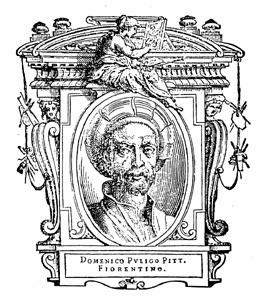
Domenico Puligo (1492–1527) was an Italian painter of the Renaissance, active in Florence. His real name was Domenico di Bartolomeo Ubaldini.

Florentine painting or the Florentine School refers to artists in, from, or influenced by the naturalistic style developed in Florence in the 14th century, largely through the efforts of Giotto di Bondone, and in the 15th century the leading school of Western painting. Some of the best known painters of the earlier Florentine School are Fra Angelico, Botticelli, Filippo Lippi, the Ghirlandaio family, Masolino, and Masaccio.

This article about the development of themes in Italian Renaissance painting is an extension to the article Italian Renaissance painting, for which it provides additional pictures with commentary. The works encompassed are from Giotto in the early 14th century to Michelangelo's Last Judgement of the 1530s.
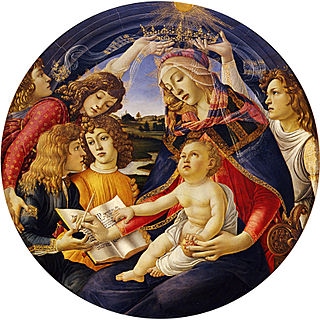
The Madonna of the Magnificat, is a painting of circular or tondo form by the Italian Renaissance painter Sandro Botticelli. It is also referred to as the Virgin and Child with Five Angels. In the tondo, we see the Virgin Mary writing the Magnificat with her right hand, with a pomegranate in her left, as two angels crown her with the Christ child on her lap. It is now in the galleries of the Uffizi, in Florence.
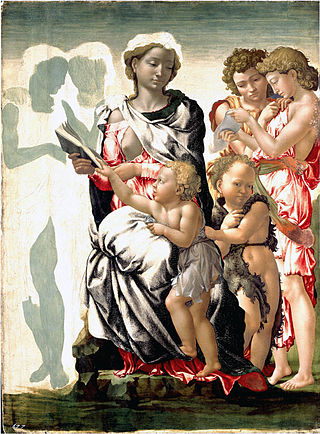
The Madonna and Child with St John and Angels (c. 1497), also known as The Manchester Madonna, is an unfinished painting in the National Gallery, London, attributed to Michelangelo. It is one of three surviving panel paintings attributed to the artist and has been dated to his first period in Rome. The work first came to public attention in the Art Treasures Exhibition in Manchester in 1857, hence the title the "Manchester Madonna". Attribution of the painting to Michelangelo was in doubt for much of the nineteenth and twentieth centuries, but now most scholars are in agreement.

Andrea del Sarto was an Italian painter from Florence, whose career flourished during the High Renaissance and early Mannerism. He was known as an outstanding fresco decorator, painter of altar-pieces, portraitist, draughtsman, and colorist. Although highly regarded during his lifetime as an artist senza errori, his renown was eclipsed after his death by that of his contemporaries Leonardo da Vinci, Michelangelo, and Raphael.
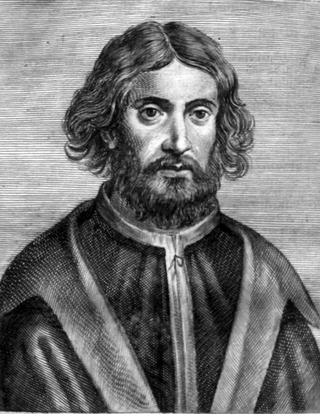
Palma Vecchio, born Jacopo Palma, also known as Jacopo Negretti, was a Venetian painter of the Italian High Renaissance. He is called Palma Vecchio in English and Palma il Vecchio in Italian to distinguish him from Palma il Giovane, his great-nephew, who was also a painter.
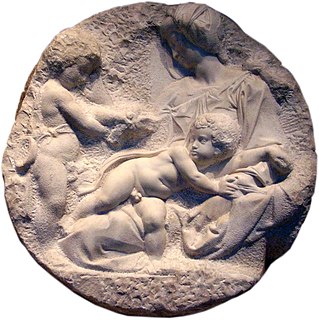
The Taddei Tondo or The Virgin and Child with the Infant St. John is an unfinished marble relief tondo of the Madonna and Child and the infant Saint John the Baptist, by the Italian Renaissance artist Michelangelo Buonarroti. It is in the permanent collection of the Royal Academy of Arts in London. The tondo is the only marble sculpture by Michelangelo in Great Britain. A "perfect demonstration" of his carving technique, the work delivers a "powerful emotional and narrative punch".
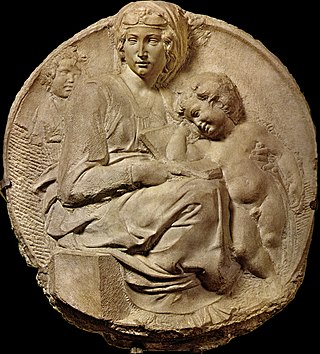
The Pitti Tondo is an unfinished marble relief of the Virgin and Child by Michelangelo in round or tondo form. It was executed between 1503 and 1504 while he was residing in Florence and is now in the Museo nazionale del Bargello in Florence.
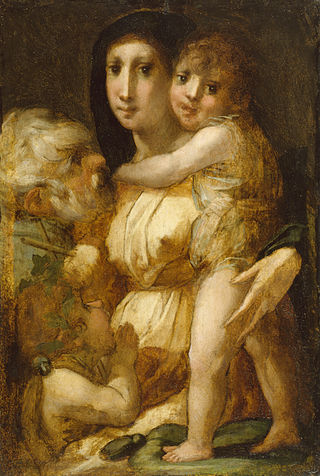
Holy Family with the Infant Saint John the Baptist is an unfinished c. 1521 oil on panel painting by Rosso Fiorentino, produced early in his stay in Volterra. The work is now in the Walters Art Museum in Baltimore.

Assumption of the Virgin is a fresco by Rosso Fiorentino in the Chiostro dei Voti of the Basilica della Santissima Annunziata in Florence.

Coronation of the Virgin is an oil-on-canvas painting executed c. 1539 by the Italian Renaissance painter Domenico Beccafumi, now in the Pinacoteca nazionale in Siena.

The Bridgewater Madonna is a religious painting by Raphael, dated 1507. Originally on oil and wood, but later transferred to canvas, it measures 81 by 55 cm. The picture is part of the permanent collection of the Scottish National Gallery in Edinburgh, on loan from the Duke of Sutherland Collection.
